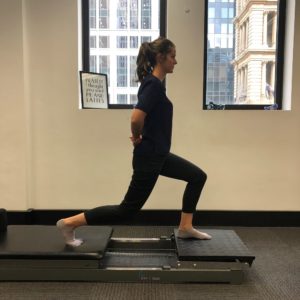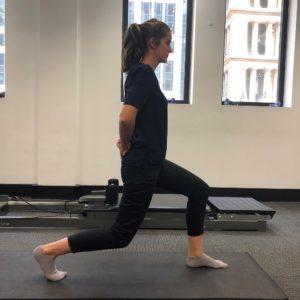In this blog we are going to add another exercise to the ‘Pilates Reformer vs Mat exercise’ blog series. This blog will talk about how lunges can be done on both the mat and on the reformer., along with the different stability challenges associated with each.
For both the mat and the reformer, lunges can be done a few different ways so to keep it simple I will only demonstrate one variation in this blog.
Mat:
When lunging on the mat you will step one leg back behind you and bend both knees to 90 degrees. You want to step far enough back so that you can get this 90 degree bend in your knees. If you step back too close you will find your knees in an awkward position which may result in some knee pain. Your back leg should be parallel to your standing leg and in line with your hip as if your feet are on train tracks. Once you are down in the lunge make sure your hips square to the direction you are facing (your back leg hip may want to shift backwards). Your front knee should be sitting over your mid foot and pointing out towards your third toe. This will ensure the knee doesn’t have any uncomfortable force through the the joint. You will then use your front standing leg glute (bottom muscle) to stand up and bring the back leg to your starting position.
When using the reformer for lunges you won’t need to step the leg backwards as the carriage will slide you back into the lunge position. Whilst you would think this makes it easier for your legs it adds a stability challenge to the process. The spring is often light for this exercise which helps to target your front standing glute. This means you need to use both your deep abdominals and hip stabilisers to keep yourself upright when doing this movement on the reformer. When a patient first starts this exercise on the reformer we sometimes get them to hold a pole for balance as it can initially be quite a challenge. The same positioning techniques applies as on the mat (hips square, knees 90 degrees, knee over midfoot and pointing towards third toe). As the patient stands up they will activate their front leg glute muscles and bring the carriage back to the platform.
 This is just one example of an exercise which can be done on both the mat and reformer. Keep a look out on the Bend + Mend blog page to see some more Pilates reformer vs Mat Exercises.
This is just one example of an exercise which can be done on both the mat and reformer. Keep a look out on the Bend + Mend blog page to see some more Pilates reformer vs Mat Exercises.
If you would like a personalised physiotherapy exercise program using clinical pilates equipment come in for an assessment with one of our Bend + Mend Physios today.






